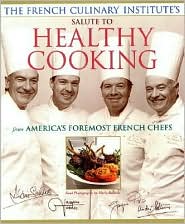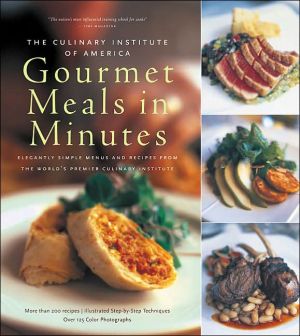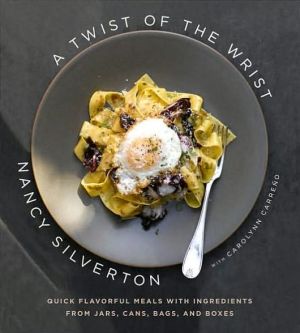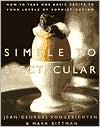French Culinary Institute's Salute to Healthy Cooking
For the first time, chefs from New York City's renowned French Culinary Institute have created a collection of recipes that are not only delicious, but also easy and low in fat. You'll learn from chefs like Jacques Pepin how to create dishes worthy of restaurants like Le Cirque. The chefs share 40 seasonal menus that use only the freshest, tastiest, healthiest ingredients for a distinctly French taste.
Search in google:
The holidays are winding down, and it's time to start thinking about those resolutions again. Are you going to pledge to start cooking healthier, lower-fat food this year? There are a number of great books that can show you how it's done -- withou t forcing you to delve into the often unsatisfying world of fake low-fat products. We've collected our favorites to get you started, including The French Culinary Institute's Salute to Healthy Cooking Publishers Weekly Culinary authority doesn't come much higher than these four chefs associated with the New York school founded in 1984, who offer 150 seasonally arranged recipes offered in three-course menus for health-conscious home cooks. In general, their collective approach calls for less saturated fat, less meat and more fruits and vegetables. Key techniques include cooking in nonstick pans with a minimum of fat (11/2 pounds of meat are saut ed in one teaspoon of olive oil for Lamb Stew with Glazed Turnips and Pearl Onions, serving four); making use of vegetable essences -- water in which a flavoring agent is simmered for 45 minutes and then often reduced (Breast of Chicken with Fennel essence); using nonfat dairy products (Low-Fat Caramel Cream made with 1% milk). Large flavors also disguise the decrease of fat in such dishes as Baked Cod with Tomatoes, Capers and Turmeric on Saut ed Spinach and Roasted Chicken with Grapefruit and Pink Peppercorn Sauce. Sauces are another focus, as with the almost fat-free Spinach and Watercress Sauce, with chicken stock thickened with potato. Phyllo dough replaces the traditional p t bris e (e.g., Apricot Tart). When Basic Pastry is a necessity, the solution is one made with a tablespoon of canola oil and 1/4 cup of low-fat cottage cheese. These are generally easily rendered recipes that retain a French air even though calories and fat grams are listed.
\ From Barnes & NobleHow do the French eat a luxuriously delicious diet and still escape high rates of heart disease? Perhaps it's the deep pleasure they take in food and wine -- eating on the run is a sacrilege in France. And the truth is, French everyday cooking is less rich than we often assume -- it's based on a wide variety of healthful vegetables and grains enlivened with modest amounts of meat and flavorful fats. Chefs Alain Sailhac, Jacques Pépin, André Soltner, and Jacques Torres of the French Culinary Institute highlight the healthy side of elegant, simple French cuisine in their excellent new book, The French Culinary Institute's Salute to Healthy Cooking.\ \ \ \ \ Publishers Weekly - Publisher's Weekly\ Culinary authority doesn't come much higher than these four chefs associated with the New York school founded in 1984, who offer 150 seasonally arranged recipes offered in three-course menus for health-conscious home cooks. In general, their collective approach calls for less saturated fat, less meat and more fruits and vegetables. Key techniques include cooking in nonstick pans with a minimum of fat (11/2 pounds of meat are saut ed in one teaspoon of olive oil for Lamb Stew with Glazed Turnips and Pearl Onions, serving four); making use of vegetable essences -- water in which a flavoring agent is simmered for 45 minutes and then often reduced (Breast of Chicken with Fennel essence); using nonfat dairy products (Low-Fat Caramel Cream made with 1% milk). Large flavors also disguise the decrease of fat in such dishes as Baked Cod with Tomatoes, Capers and Turmeric on Saut ed Spinach and Roasted Chicken with Grapefruit and Pink Peppercorn Sauce. Sauces are another focus, as with the almost fat-free Spinach and Watercress Sauce, with chicken stock thickened with potato. Phyllo dough replaces the traditional p t bris e (e.g., Apricot Tart). When Basic Pastry is a necessity, the solution is one made with a tablespoon of canola oil and 1/4 cup of low-fat cottage cheese. These are generally easily rendered recipes that retain a French air even though calories and fat grams are listed.\ \ \ Library JournalNew York City's French Culinary Institute (FCI) has an impressive roster of chefs leading it: Alain Sailhac, who has been chef of Le Cirque and other renowned restaurants; Jacques Pepin, well known for his PBS series and many cookbooks; Andre Soltner, chef/owner of Lutece for more than 30 years; and Jacques Torres, pastry chef at Le Cirque 2000. They have put together a selection of low-fat, low-calorie seasonal menus, with the emphasis on fresh fruits and vegetables, fresh herbs, and intense flavors. The recipes are often complex (after all, they are teaching cooking at FCI), more appropriate for entertaining than for a simple healthy family meal -- for example, Baby Artichokes in Vegetable Broth, Poached Lobster with Saffron Sabayon, and Crispy Napoleon with Fresh Fruit. Full-page color photographs show off the elegant presentations. For larger low-fat collections and other libraries where chefs' books are popular.\ \ \ \ \ Kate MurphyEveryone knows that the French manage to eat some of the richest, most delicious food in the world and yet have a lower rate of heart disease than Americans do. Doctors are still debating exactly why. Most likely, a number of factors contribute to the phenomenon, including the fact that, like the people of many Mediterranean-influenced cultures, the French eat a wide variety of vegetables, grains, legumes, fruits, and other healthy foods with meat generally in small portions. But ask a Frenchman what's behind the French paradox and he's likely to say that it's the pleasure that the French take in good food and wine. As Chef Alain Sailhac says, "We savor both the food and the company. Almost nowhere in France do you see people standing up to eat a meal on the run as so many Americans do." \ Sailhac, former chef of Le Cirque and dean of The French Culinary Institute, has teamed up with well-known French chefs Jacques Pepin, André Soltner, and Jacques Torres -- all his colleagues on the faculty -- to produce a wonderful new book that shows readers how to retain all the pleasure inherent in French cuisine while losing some of the fat. In The French Culinary Institute's Salute to Healthy Cooking, the chefs not only offer an impressive array of elegant, healthy recipes, they provide an excellent education for home cooks looking to adapt everyday meals to a healthy style of cooking, including advice on incorporating antioxidant-rich foods into the diet, using low-fat tricks and cooking techniques, and mastering lightened recipes for basics like vegetable stock and low-fat béchamel sauce. The recipes are usefully arranged into seasonal menus -- try Asparagus Soup, Breast of Chicken with Fennel, and Strawberries Marinated in Port for an elegant spring dinner; or Leeks Vinaigrette with Roasted Red Peppers, Lamb Stew with Glazed Turnips and Pearl Onions, and Roasted Apples Wrapped in Phyllo as autumn weather sets in. This is the kind of healthy food one can eat day-in, day-out, without ever feeling deprived. On the contrary, cooking from The French Culinary Institute's Salute to Healthy Cooking , will give you a taste of what taking real pleasure from everyday meals can be like.\ \ \








